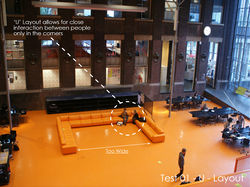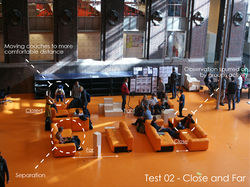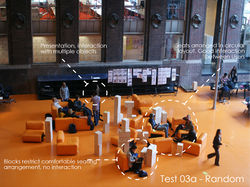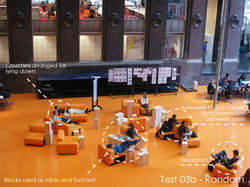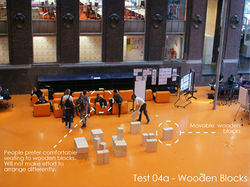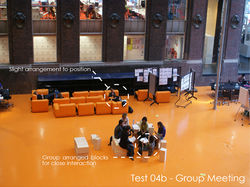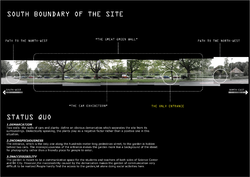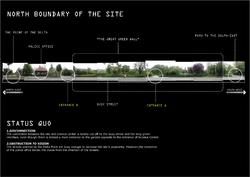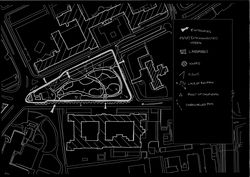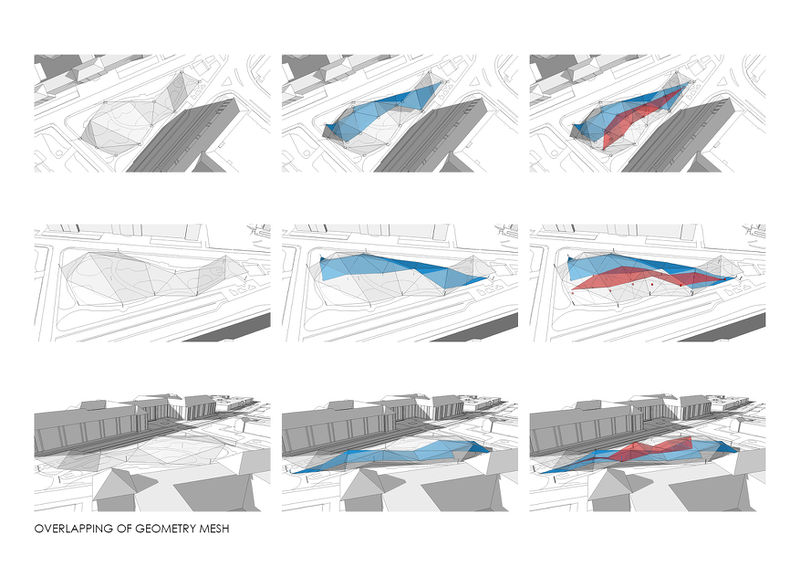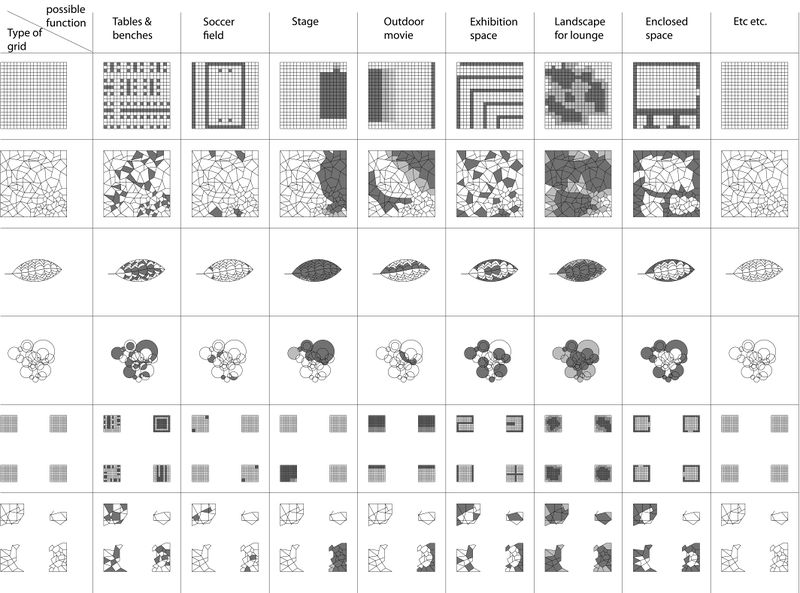atom07:Research
(→Site Analysis) |
|||
| (273 intermediate revisions by 3 users not shown) | |||
| Line 1: | Line 1: | ||
| − | = | + | __NOTOC__ |
| − | + | <div style="float: left; width: 800px; margin-right:20px; text-align:right:justify"> | |
| − | + | ==''Experimentation''== | |
| − | + | ===1. User - object interaction=== | |
| − | + | In the Orange Lecture hall several seating arrangements were set up to see the response from people. The users were able to adapt to the experiment to suite their demands. The set ups varried from comfortable to obstructive seating layouts. | |
| + | <youtube width="800" height="520" left >TJszqSiY_kY</youtube> | ||
| − | + | conclusions: | |
| + | - Bigger effort made to have a comfortable seat. | ||
| − | + | - Diverse arangement of spaces, caters for larger user group. | |
| − | + | ||
| − | + | ||
| + | - People sit closer to their point of interest. | ||
| + | - Person will adapt to given situation. | ||
| − | + | - People only change elements when necessary. | |
| − | + | - Difficulties changing elements embarrass people. | |
| − | + | [[Image:Observation_.jpg|Test01|250px]] [[Image:Observation_2.jpg|Test02|250px]] [[Image:Observation_3.jpg|Test03|250px]] | |
| + | [[Image:Observation_3b.jpg|Test03|250px]] [[Image:Observation_4.jpg|Test4a|250px]] [[Image:Observation_5.jpg|Test04b|250px]] | ||
| − | + | ='''Site'''= | |
| − | |||
| − | + | The site in front of BK-City, the "van heijplantsoen" has some nice quality's which are unique to a park. It has diverse vegetation, a nice view of open space and also the view to the build surrounding is really nice. However, the park is not being used. The thick borders and disruptive influences like sound make the park uninviting. | |
| + | [[File:diagram_site 1.png|250px]] [[File:diagram_site 2.png|250px]] [[Image:Kevin_Lynch_Sketch.jpg|250px]] | ||
| − | The | + | <youtube width="300" height="196" left >84sCV8FNHlA</youtube> |
| + | The video of the site demonstrates its emptiness. By doing similar experimentation to that of the seating arrangement in the Orange lecture hall, more interaction will take place. This will cause the site to flourish with more activities. | ||
| − | + | '''<u>[[Atom07: Site Qualities|Additional Information on Site Qualities]]</u>''' | |
| − | + | ||
| − | + | ==''GPRS Mapping''== | |
| + | From Kevin Lynch’s empirical research on how individuals perceive and navigate through a site has led to research done using GPRS tracking devices for site analysis. | ||
| + | [[Image:GPS_Analysis.jpg|GPRS tracking devices mapped three different activities on the site|800px]] | ||
| + | [[Image:GPS_Analysis2.jpg|Overlapping Mesh from GPRS|800px]] | ||
| + | A mesh between different GPRS points is overlaid. The images show 3 different meshes; intimate (red), open space (blue), paths and nodes (white). On the different meshes are overlaid over each other to see the effect of how different activities are linked and intertwined. To conclude, the overlapping parts of the mesh creates hotspots for potential of a variety of programmes to occur without disrupting the original scheme of the park. | ||
| − | [[ | + | <u>'''[[Atom07: Research Validation | Research Validation]]'''</u> |
| + | ='''Technical Design Challange'''= | ||
| + | The concept of having a changeable environment automatically is inherent to using new technique's. For this concept a concrete wall wouldn't work. | ||
| + | For the execution of this project, exploration of possibilities were tested. The different grids are an exploration of possible grid layouts that may be appropriate for the site. | ||
| + | ==''Grid''== | ||
| + | [[File:Diagram_shape_intervention-Model(color)small.jpg|800px|Multi Programmable space]] | ||
| + | [[atom07: Large version lay out diagram | High resolution ]] | ||
| − | + | Conclusion: Most functions are possible with a range of grid layouts. Irregular prove to be a bit inefficient in some set ups. A good approach to scripting techniques can overcome this problem. Irregular also delivers some interesting shape's and is not clear at first sight, which would fit the concept of ineffable space. Seperate grids spread around give some problems for the larger activity's, but can be a welcome addition to the space. | |
| − | + | ||
| − | + | ||
| − | + | ||
| − | + | ||
| − | + | ||
| − | + | ||
| − | + | ||
| − | + | ||
| − | + | ||
| − | + | ||
| − | + | ||
| − | + | ||
| − | + | ||
| − | + | ||
| − | + | ||
| − | + | ||
| − | + | ||
| − | + | ||
| − | + | ||
| − | + | ||
| − | + | ||
| − | + | ||
| − | + | ||
| − | + | ||
| − | + | ||
| − | + | ||
| − | + | ||
| − | + | ||
| − | + | ||
| − | + | ||
| − | + | ||
| − | + | ||
| − | + | ||
| − | + | ||
| − | + | ||
| − | + | ||
| − | + | ||
| − | + | ||
| − | + | ||
| − | + | ||
| − | + | ||
| − | + | ||
| − | + | ||
| − | + | ||
| − | + | ||
| − | + | ||
| − | + | ||
| − | + | ||
| − | + | ||
| − | + | ||
| − | + | ||
| − | + | ||
| − | + | ||
| − | + | ||
| − | + | ||
| − | + | ||
| − | + | ||
| − | + | ||
| − | + | ||
| − | + | ||
| − | + | ||
| − | + | ||
| − | + | ||
| − | + | ||
| − | + | ||
| − | + | ||
| − | + | ||
| − | + | ||
| − | + | ||
| − | + | ||
| − | + | ||
| − | + | ||
| − | + | ||
| − | + | ||
| − | + | ||
| − | + | ||
| − | + | ||
| − | + | ||
| − | + | ||
| − | + | ||
| − | + | ||
| − | + | ||
| − | + | ||
| − | + | ||
| − | + | ||
| − | + | ||
| − | + | ||
| − | + | ||
| − | + | ||
| − | + | ||
| − | + | ||
| − | + | ||
| − | + | ||
| − | + | ||
| − | + | ||
| − | + | ||
| − | + | ||
| − | + | ||
| − | + | ||
| − | + | ||
| − | + | ||
| − | + | ||
| − | + | ||
| − | + | ||
| − | + | ||
| Line 161: | Line 69: | ||
[[atom07: Home | '''<<Back''']] | [[atom07: Home | '''<<Back''']] | ||
| − | + | </div> | |
| − | + | ||
| − | + | ||
| − | + | ||
| − | + | ||
| − | + | ||
| − | + | ||
| − | + | ||
| − | + | ||
| − | + | ||
| − | + | ||
| − | + | ||
| − | + | ||
| − | + | ||
| − | + | ||
| − | + | ||
| − | + | ||
| − | + | ||
| − | + | ||
| − | + | ||
| − | + | ||
| − | + | ||
| − | + | ||
| − | + | ||
| − | + | ||
| − | + | ||
| − | + | ||
| − | + | ||
| − | + | ||
Latest revision as of 11:54, 17 October 2011
Experimentation
1. User - object interaction
In the Orange Lecture hall several seating arrangements were set up to see the response from people. The users were able to adapt to the experiment to suite their demands. The set ups varried from comfortable to obstructive seating layouts.
conclusions:
- Bigger effort made to have a comfortable seat.
- Diverse arangement of spaces, caters for larger user group.
- People sit closer to their point of interest.
- Person will adapt to given situation.
- People only change elements when necessary.
- Difficulties changing elements embarrass people.
Site
The site in front of BK-City, the "van heijplantsoen" has some nice quality's which are unique to a park. It has diverse vegetation, a nice view of open space and also the view to the build surrounding is really nice. However, the park is not being used. The thick borders and disruptive influences like sound make the park uninviting.
The video of the site demonstrates its emptiness. By doing similar experimentation to that of the seating arrangement in the Orange lecture hall, more interaction will take place. This will cause the site to flourish with more activities.
Additional Information on Site Qualities
GPRS Mapping
From Kevin Lynch’s empirical research on how individuals perceive and navigate through a site has led to research done using GPRS tracking devices for site analysis.
A mesh between different GPRS points is overlaid. The images show 3 different meshes; intimate (red), open space (blue), paths and nodes (white). On the different meshes are overlaid over each other to see the effect of how different activities are linked and intertwined. To conclude, the overlapping parts of the mesh creates hotspots for potential of a variety of programmes to occur without disrupting the original scheme of the park.
Technical Design Challange
The concept of having a changeable environment automatically is inherent to using new technique's. For this concept a concrete wall wouldn't work. For the execution of this project, exploration of possibilities were tested. The different grids are an exploration of possible grid layouts that may be appropriate for the site.
Grid
Conclusion: Most functions are possible with a range of grid layouts. Irregular prove to be a bit inefficient in some set ups. A good approach to scripting techniques can overcome this problem. Irregular also delivers some interesting shape's and is not clear at first sight, which would fit the concept of ineffable space. Seperate grids spread around give some problems for the larger activity's, but can be a welcome addition to the space.
